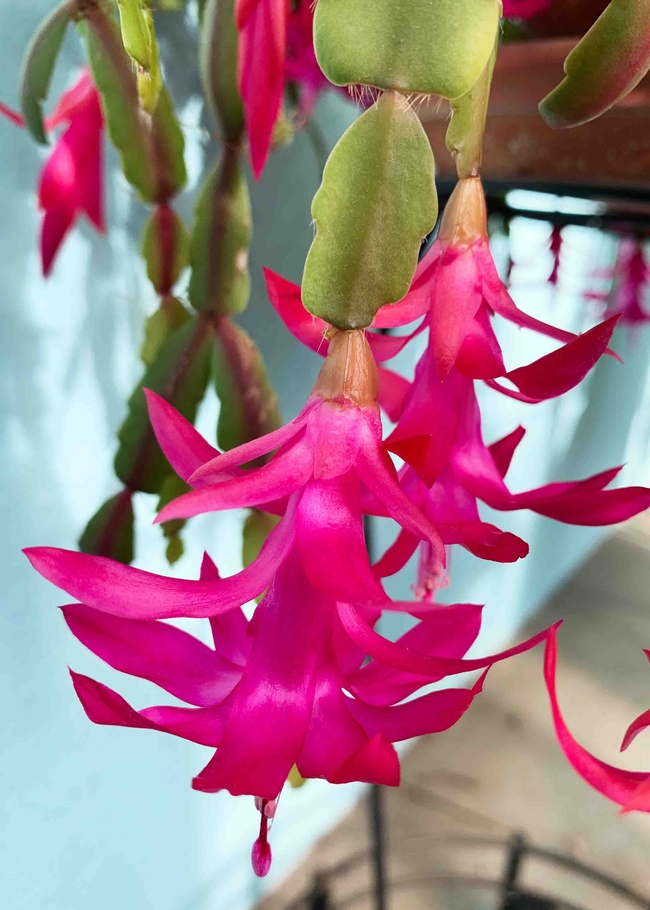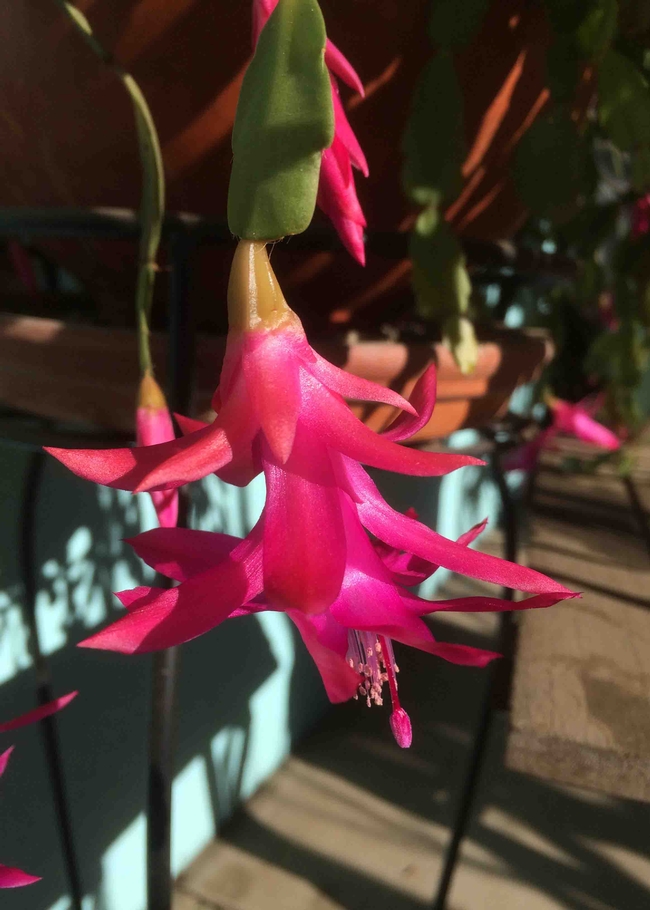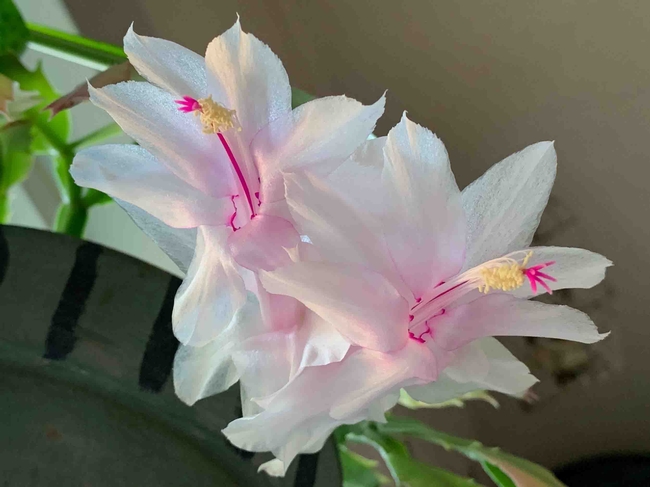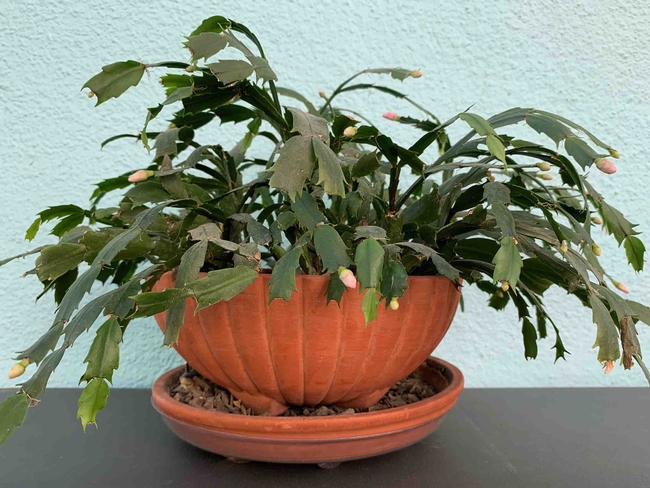Imagine a mountainous and remote rainforest along the ocean coast. Whisps of fog drift through the trees as cascades of colorful flowers sweep down from plants perched high on the tree limbs. This is the Mata Atlântica or Atlantic Forest of Brazil, a biodiversity hotspot and birthplace of the Christmas cactus or Flor de maio (May flower). In the Southern Hemisphere this plant blooms in May (autumn); in the Northern Hemisphere it blooms during the winter holidays, hence its popularity as a Christmas gift.

These plants are true members of the cactus (cactaceae) family even though they bear little resemblance to other species of cacti adapted to desert heat: they have photosynthetic stems rather than leaves and areoles rather than branches.
In spite of their cool and moist native habitat, these plants are hardy and grow well in a pot outdoors on a sheltered patio or indoors next to a window in bright, indirect light. With proper cultivation, they are also long-lived; Schlumbergera can live up to 50 years or more; many have been passed down in families as cherished heirlooms.

The common and botanical names given to these plants can be confusing, and any of them may be labeled “Christmas cactus.” So how can you identify exactly which species you have?
If the plant is in bloom, the flowers of S. truncata are zygomorphic (bilaterally symmetrical when sliced lengthwise) held more or less horizontally or above the horizontal, and the pollen is yellow; whereas the flowers of S. x buckleyi are more regular and hang down below the horizontal, with pollen that is pink. The flowers of S. gaertneri are different from the other two species because they are radially symmetrical (actinomorphic) and open to a funnel shape, like a starburst.
If the plant is not blooming, the best way to identify which species you have is by looking at the stem segments (phylloclades) that form the plant. In S. truncata the stem segments have pointed teeth (dentate), often with two large teeth at the end of the segment, while in S. x buckleyi they are rounded, with more symmetrical teeth (crenate); in S. gaertneri the segments are very rounded with small notches along the edge at the aeroles. For helpful illustrations of all of these species, see Is it a Thanksgiving, Christmas or Easter Cactus? - World of Succulents
Indeed, some sources claim that the Thanksgiving cactus Schlubergera truncata is actually the one that is widely marketed as Christmas cactus.
A Brief History
Christmas cacti have been given as holiday gifts since the second half of the 19th century. Charles Lemaire, a French botanist, named the genus Schlumbergera in 1858, commemorating Frédéric Schlumberger, who had a collection of cacti at his chateau in France. Lemaire began with only one species in his new genus – a plant discovered in Brazil in 1837 which is now classified as Schlumbergera russelliana.
Schlumbergera truncata (Thanksgiving cactus) was cultivated in Europe starting in 1818, and S. russelliana was introduced in 1839. The two species were deliberately crossed in England, resulting in the hybrid now called Schlumbergera × buckleyi, first recorded in 1852, the true Christmas cactus.
Schlumbergera gaertneri (Easter Cactus) was first described in 1884 as the variety gaertneri ofSchlumbergera russelliana). The name honors one of the Gaertner family, early settlers in Brazil.
These winter and spring-blooming species are three of the seven recognized species within the genus Schlumbergera. In addition, there are hundreds of modern cultivars (breeder-selected cultivated varieties) of the Christmas cactus.
Care and Feeding
Schlumbergera cacti do best in temperatures ranging from 50 to 70 degrees F, which makes them an obvious choice for a houseplant, but they can also live outside if they are sheltered from direct, intense sun, heat and frost. These rainforest plants need humidity. An indoor environment such as a kitchen with bright indirect light is perfect, or you can provide humidity by misting the plant or placing the pot on a saucer of pebbles filled with water so that the plant benefits from evaporation but doesn't sit in water. In their native habitat, these plants may get up to 17 inches of rain a month during their growing season (March to September). Although this drops to as little as 3 inches per month in the dry season, it's still enough to provide consistent moisture and humidity (Geisel & Unruh, Holiday Cacti).

Blooming and Propagation
The trickiest aspect of Schlumbergera cultivation is getting them to bloom abundantly every year at holiday time. Schlumbergera are thermophotoperiodic, which means that temperature and short days (fewer hours of daylight) trigger bloom. Even with good care, they will probably bloom sparingly unless exposed to cool nighttime temperatures (50 to 55 degrees F) and 12 to 16 hours a day of total darkness starting about six to eight weeks ahead of their flowering period.

When flower buds are set, keep the plant away from heater vents, fireplaces and other sources of hot air; continuous warm temperatures, especially above 80 degrees, can cause the flower buds to drop. Once the plant is blooming, make sure it is regularly watered, but do not fertilize.
Schlumbergera usually remain in flower for four to six weeks and then enter a rest period, followed by a new growth cycle. After blooming is a good time to prune and shape the plant. You can use the pruned sections to easily start new plants. Allow the cut ends to dry (callus) for a few days, and then insert them about 1 inch deep in moist, clean potting mix (5 cuttings in a 6-inch pot). Use of a rooting hormone is usually not needed. Cover the pot or tray with a clear plastic bag to create a more humid environment, making sure the bag is held up and away from the cuttings.
Although far from their native rainforest home, exotic Schlumbergera cacti still brighten our winter holidays with the gift of spectacular color and beauty.
Other References
Finigan, Monica. A Tale of Two Cacti, UC Master Gardeners of Napa County, Regents of the University of California, Division of Agriculture and Natural Resources. December 9, 2015.
Hartin, Janet. “Was that Gift Really a Christmas Cactus…or Something Else?” Environmental Horticulture News, Regents of the University of California, Division of Agriculture and Natural Resources, 2021.
Perry, Ed. “The Christmas Cactus,” The Stanislaus Sprout, Regents of the University of California, Division of Agriculture and Natural Resources, December 14, 2020.
UC Master Gardeners of Butte County are part of the University of California Cooperative Extension (UCCE) system. To learn more about us and our upcoming events, and for help with gardening in our area, visit our website. If you have a gardening question or problem, email the Hotline at mgbutte@ucanr.edu (preferred) or call (530) 538-7201.